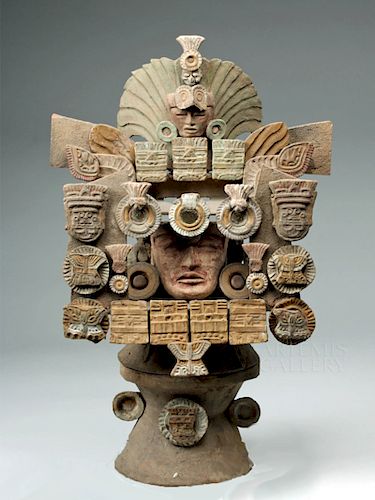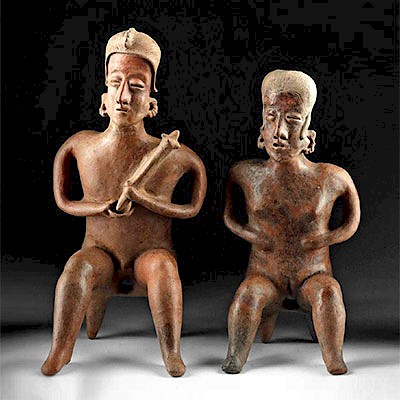Teotihuacan Terracotta Incensario - Theater Type w/ TL
Lot 140
About Seller
Artemis Fine Arts
686 S Taylor Ave, Ste 106
Louisville, CO 80027
United States
Selling antiquities, ancient and ethnographic art online since 1993, Artemis Gallery specializes in Classical Antiquities (Egyptian, Greek, Roman, Near Eastern), Asian, Pre-Columbian, African / Tribal / Oceanographic art. Our extensive inventory includes pottery, stone, metal, wood, glass and textil...Read more
Estimate:
$15,000 - $20,000
Absentee vs Live bid
Two ways to bid:
- Leave a max absentee bid and the platform will bid on your behalf up to your maximum bid during the live auction.
- Bid live during the auction and your bids will be submitted real-time to the auctioneer.
Bid Increments
| Price | Bid Increment |
|---|---|
| $0 | $25 |
| $300 | $50 |
| $1,000 | $100 |
| $2,000 | $250 |
| $5,000 | $500 |
| $10,000 | $1,000 |
| $20,000 | $2,500 |
| $50,000 | $5,000 |
| $100,000 | $10,000 |
| $200,000 | $20,000 |
About Auction
By Artemis Fine Arts
May 23, 2019
Set Reminder
2019-05-23 10:00:00
2019-05-23 10:00:00
America/New_York
Bidsquare
Bidsquare : Exceptional Day 2 Ethnographic Tribal Fossils
https://www.bidsquare.com/auctions/artemis-gallery/exceptional-day-2-ethnographic-tribal-fossils-4136
Day 2 of an important 2-day auction featuring exceptional ethnographic art from around the world. Today's sale will feature Pre-Columbian from the ancient americas, Native American, African / Tribal, Oceanic, Spanish Colonial, and incredible Fossils. Artemis Fine Arts info@artemisfinearts.com
Day 2 of an important 2-day auction featuring exceptional ethnographic art from around the world. Today's sale will feature Pre-Columbian from the ancient americas, Native American, African / Tribal, Oceanic, Spanish Colonial, and incredible Fossils. Artemis Fine Arts info@artemisfinearts.com
- Lot Description
Pre-Columbian, Mexico or Guatemala, Teotihuacan, ca. 450 to 650 CE. An exceptional incensario (incense burner) of a remarkably complete form - including the elaborate chimney lid and hourglass shaped base - called a theater-type incensario because the face wearing a spectacular headdress & earplugs is looking out from a stage with a proscenium adorned by many symbolic appliques called adornos - a complex, multidimemnsional structure covered with these press-molded symbolic ornaments, including three butterflies, a pair of owls at the lower corners, two headdress donning deities at the upper corners, several glyph-like plaques, feathers, flowers, and a trio of roundels across the top inlaid with mirrors. The headdress presents a deity maskette donning a bird mask headband, large earspools, with a dramatic spray of plumage behind topped by yet another visage wearing a headdress. A considerable amount of extant original pigment in yellow, blue-green, and red-brown hues remains. Size: 27" L x 17" W (68.6 cm x 43.2 cm); 27.25" H (69.2 cm) on included custom stand.
Numerous scholars have suggested that censers like this example were instrumental to a cult dedicated to warriors killed in combat. Hence, the piece may represent the Great Goddess believed to have been the goddess of the underworld, war, darkness, earth, water, and creation. The owls depicted on the incensario support this as owls were considered creatures of darkness by the ancients of the Americas. What's more the Great Goddess usually wears a bird headdress as depicted on the uppermost visage of this piece. This incensario may also reference the Butterfly God given the surrounding butterflies. Indeed Kubler (1972) and von Wnning (1987) associated butterflies with the deceased. (The Teotihuacan Trinity: The Sociopolitical Structure of an Ancient . . ." by Annabeth Headrick, University of Texas Press, 2007).
This censer is known as a "theater type" and is among the most emblematic articles of visual culture of Teotihuacan. These were first created in the Tzacualli period (1 to 100 CE), and during the following years until the demise of Teotihuacan, artisans created more and more intricate compositions. Molds were used to make various ornaments that were glued to the primary body and the plates were arranged in superimposed planes as we see in this example. The numerous molded motifs include zoomorphic entitites such as birds, butterflies, and snails; phytomorphic entities such as corn, pumpkins, cotton etc.; and anthropomorphic masks with attributes belonging to warriors, leaders, or deities; as well as glyph plaques.
Many cultures throughout the world have used incense for both religious and secular purposes, and the Pre-Columbian Teotihuacan peoples were no exception. Their unique aesthetic is displayed in this beautiful incensario; note the decidedly angular facial features and bold lines which are characteristic of the Teotihuacan style. Incense and other materials were burned as food for the gods, as it was believed that the deities could only consume substances that were burned and offered to them in the form of smoke that flowed upward toward the celestial realm.
Compare to a similar example published in "Teotihuacan Art From the City of the Gods," edited by Kathleen Berrin and Esther Pasztory, Thames and Hudson: The Fine Arts Museums of San Francisco, 1993, p. 217. Another useful source is, "The Teotihuacan Trinity: The Sociopolitical Structure of an Ancient . . ." by Annabeth Headrick, University of Texas Press, 2007.
This piece has been tested using thermoluminescence (TL) and has been found to be ancient and of the period stated. A full report will accompany purchase.
Provenance: private S.H. collection, Santa Clara, California, USA; purchased from Alcala Gallery, San Diego, California, USA
All items legal to buy/sell under U.S. Statute covering cultural patrimony Code 2600, CHAPTER 14, and are guaranteed to be as described or your money back.
A Certificate of Authenticity will accompany all winning bids.
We ship worldwide and handle all shipping in-house for your convenience.
#129190Repaired from multiple pieces. Losses to adornos including roundel behind one owl and ear of the other owl as well as peripheries of others. Expected nicks and abrasions to peripheries of the lid and base as well as normal surface wear commensurate with age. Liberal original pigments remain. Nice manganese deposits as well.Condition
- Shipping Info
-
All shipping is handled in-house for your convenience. Your invoice from Artemis Gallery will include shipping calculation instructions. If in doubt, please inquire BEFORE bidding for estimated shipping costs for individual items.
-
- Buyer's Premium



 EUR
EUR CAD
CAD AUD
AUD GBP
GBP MXN
MXN HKD
HKD CNY
CNY MYR
MYR SEK
SEK SGD
SGD CHF
CHF THB
THB



















